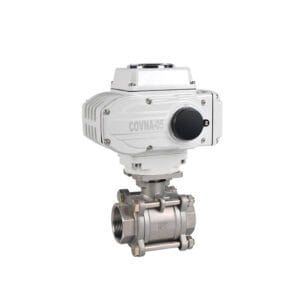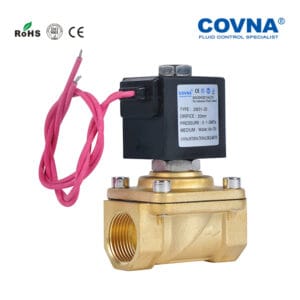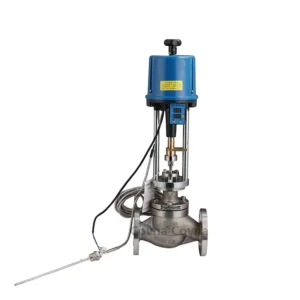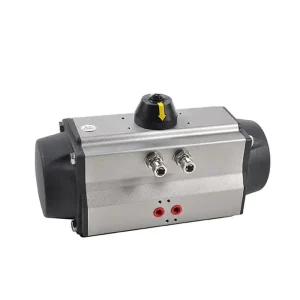COVNA Products
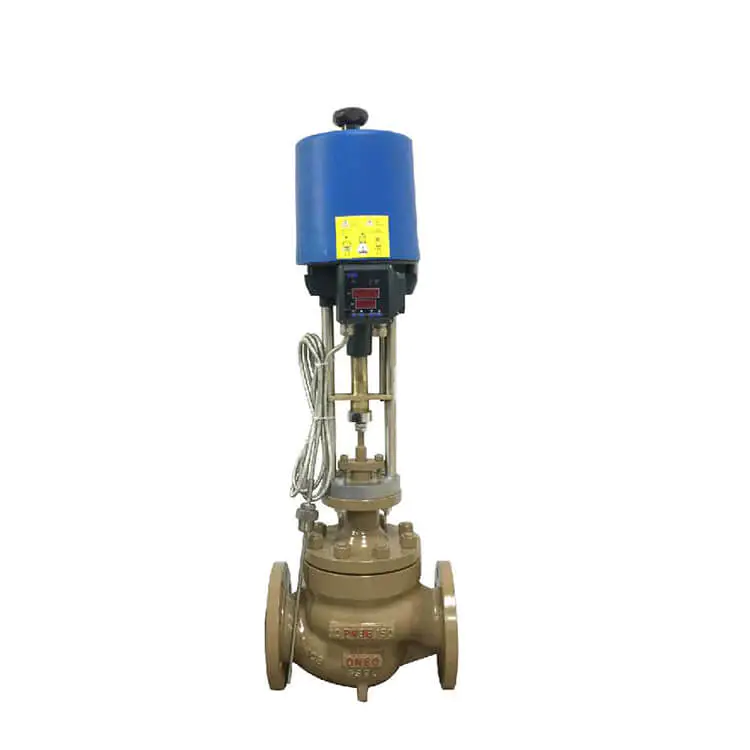
HK-C Electric Control Valve
Control valves help manage flow, pressure, and level in pipelines. They automatically adjust valve opening based on position signals to maintain the desired flow, pressure, or level.
An electric control valve is a type of control valve whose electric actuator controls the valve's opening or closing. This actuator is a critical component of plant process control, allowing for automated and precise flow management.
Contact us today to find the perfect control valve for your application!
Model
- Actuator Type :Electronic Electric Actuator
- Body Material: WCB or Stainless Steel 304/316/316L
- Pressure: 10 / 16 / 20 / 40 / 64 Bar (145 / 232 / 290 / 580 / 928 psi)
- Temperature Of Media: -40 to 450℃ (-40℉ to 842℉)
- Suitable Media: Water, Air, Oil, Gas, Steam, etc
- Voltage: AC220V 50Hz
- Connection Type: Flanged (ANSI, JIS, DIN, GB)
Technical Parameter of Electric Control Valve:
| Nominal Diameter (mm) | 25 | 40 | 50 | 65 | 80 | 100 | 150 | 200 | 250 | 300 | |||
| Rated Flow Coefficient Kv | Straight Line | 6.9 11 | 17.6 | 27.5 | 27.5 44 | 44 69 | 69 110 | 110 176 | 275 | 440 | 440 690 | 690 1000 | 1000 1600 |
| Equal Percentage | 6.3 10 | 16 | 25 | 25 40 | 40 63 | 63 100 | 100 160 | 250 | 400 | 400 630 | 630 900 | 900 1400 | |
| Rated Stroke | 16 | 25 | 40 | 59 | 100 | ||||||||
| Actuator Model | 381LSB-20 | 381LSB-30 | 381LSB-50 | 381LSB-65 | 381LSB-99 | ||||||||
| Allow Differential Pressure | 6.4 | 4.2 | 4.6 | 3.7 | 2.7 | 2.2 | |||||||
| Control Signal | 4-20mA dc, 1-5 Vdc | ||||||||||||
| Power Supply | 220C AC 50Hz | ||||||||||||
| Nominal Pressure (bar) | 16 / 40 / 64 | ||||||||||||
| Operating Temperature | WCB: -40℃to 250℃or -40 to 450℃ Stainless Steel: -40℃to 250℃or -60℃ to 450℃ | ||||||||||||
| Intrinsic Flow Characteristics | Straight line, equal percentage(inherent adjustable ratio 50:1) | ||||||||||||
| Valve body | ZG230-450, ZG1Cr18Ni9Ti, ZG0Cr18Ni12Mo2Ti, or equivalent US brand WCB, CF8, CF8M |
| Spool, Sleeve single seat | 1Cr18Ni9Ti, 0Cr18Ni12Mo2Ti, or similar US grade 304, 316 |
| Filler | Polytertrafluoroethylene, flexible graphite |
Technical Parameter of Electric Control Valve:
The actuator on my automated valve operates, but the valve won’t turn. Why?
Most likely the valve stem or actuator coupling is broken.
Why doesn’t my valve open or close completely when the actuator operates it?
The electric actuator limit switches or the pneumatic actuator position stops are not correctly adjusted.
When I energize the solenoid on my pneumatic actuated valve, the valve won’t turn. How come?
Probably because there is no air pressure to the solenoid or dirt has jammed it. Also, debris might be trapped inside the valve. Or, the air pressure is not sufficient to operate the actuator. Remember: measure air pressure at the actuator, not at the compressor.
Can I buy an actuator from one manufacturer and mount it to a valve from another manufacturer?
Maybe. First, be sure that the actuator torque output is sufficient to turn the valve reliably. Second, you will have to fabricate a custom mounting bracket and coupling to connect the actuator to the valve.
What happens if I lose power to my electric actuator in the middle of an actuation cycle?
The valve will stop somewhere between full open and close. When power is reapplied to the original circuit, the actuator will complete the cycle.
I ordered a fail open pneumatic actuated valve by mistake. I needed a fail closed one. What can I do?
To make the change just remove the actuator from the valve and turn it, or the valve stem, 90 degrees and remount the actuator.
I’ve installed my automated valve in the line, but now I don’t know if the valve is in the open or closed position. How can I find out?
Remove the actuator from the valve and check the valve stem. Most ball valves have stem flats at right angles to the flow when the valve is in the off position. On butterfly valves check the stem flow arrow marking.
Do I have to have the solenoid valve that controls the air supply to my pneumatic actuator mounted right on the actuator?
Remove the actuator from the valve and check the valve stem. Most ball valves have stem flats at right angles to the flow when the valve is in the off position. On butterfly valves check the stem flow arrow marking.
How do I wire up my electric actuator?
Check the electric wiring schematic that came with the actuator for the correct hookup. Sometimes a copy is inside the actuator cover. If it is missing, don’t guess about the connections. Call the manufacturer for a schematic.
I’ve just installed an electric actuated valve and when I power it, it turns the valve 360 degrees and won’t shut off. What’s wrong?
The actuator is wired incorrectly (check the schematic accompanying the actuator), or the external control switch is not the correct type for the actuator.
My electric actuators cycle time is way too fast, can I slow it down?
Not unless you bought it with an optional speed control.
I just replaced a solenoid valve with an electric actuated valve and it won’t work. Why?
Actuators and solenoid valves require different types of electrical control switches. SPDT for actuators, SPST for solenoids. Check the actuator wiring schematic for the correct wiring and switch type.


